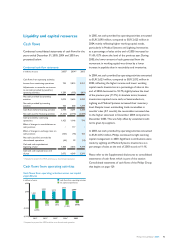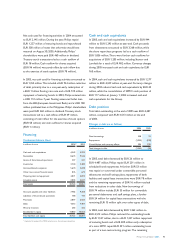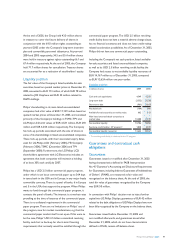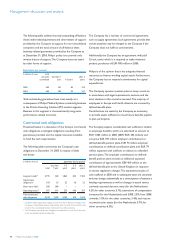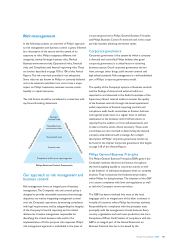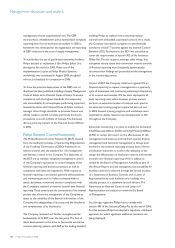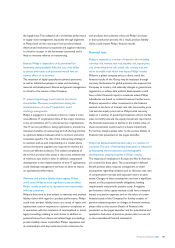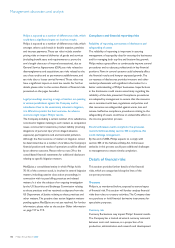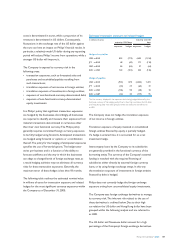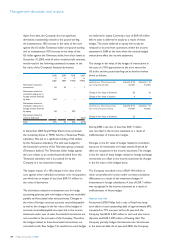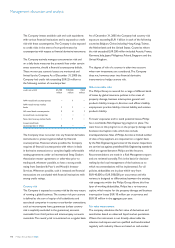Philips 2005 Annual Report Download - page 101
Download and view the complete annual report
Please find page 101 of the 2005 Philips annual report below. You can navigate through the pages in the report by either clicking on the pages listed below, or by using the keyword search tool below to find specific information within the annual report.
Philips Annual Report 2005 101
Risk management
In the following sections, an overview of Philips’ approach
to risk management and business control is given, followed
by a description of the nature and the extent of its
exposure to risks. Philips recognizes different risk
categories, namely Strategic business risks, Market/
Business-environment risks, Operational risks, Financial
risks, and Compliance and fi nancial reporting risks. These
are further described on page 103 to 106 of this Annual
Report. The risk overview provided is not exhaustive.
Some risks not yet known to Philips or currently believed
not to be material could later turn out to have a major
impact on Philips’ businesses, revenues, income, assets,
liquidity or capital resources.
The risk factors should be considered in connection with
any forward-looking statements.
Corporate Governance
Market/Business
environment risks
Strategic
business risks
Compliance and financial reporting risks
Financial risks
Operational risks
Philips Business Control Framework
Philips General Business Principles
Our approach to risk management and
business control
Risk management forms an integral part of business
management. The Company’s risk and control policy is
designed to provide reasonable assurance that strategic
objectives are met by integrating management control
over the Company’s operations, by ensuring compliance
with legal requirements and by safeguarding the integrity
of the Company’s fi nancial reporting and its related
disclosures. It makes management responsible for
identifying the critical business risks and for the
implementation of fi t-for-purpose risk responses. Philips’
risk management approach is embedded in the areas of
corporate governance, Philips General Business Principles
and Philips Business Control Framework and in the actual
periodic business planning and review cycles.
Corporate governance
Corporate governance is the system by which a company
is directed and controlled. Philips believes that good
corporate governance is a critical factor in achieving
business success. Good corporate governance derives
from, amongst other things, solid internal controls and
high ethical standards. Risk management is a well-established
part of Philips’ corporate governance model.
The quality of the Company’s systems of business controls
and the fi ndings of internal and external audits are
reported to and discussed in the Audit Committee of the
Supervisory Board. Internal auditors monitor the quality
of the business controls through risk-based operational
audits, inspections of fi nancial reporting controls and
compliance audit. Audit committees at division, business
and regional levels meet on a regular basis to address
weaknesses in the business control infrastructure as
reported by the auditors or from self-assessments, and
to take corrective action where necessary. These audit
committees are also involved in determining the desired
company-wide internal audit coverage. An in-depth
description of Philips’ corporate governance model can
be found in the chapter Corporate governance that begins
on page 218 of this Annual Report.
Philips General Business Principles
The Philips General Business Principles (GBP) govern the
Company’s business decisions and actions throughout
the world, applying equally to corporate actions as well
as the behavior of individual employees when on company
business. They incorporate the fundamental principles
within Philips for doing business. The intention of the GBP
is to ensure compliance with laws and regulations, as well
as with the Company’s norms and values.
The GBP has been translated into most of the local
languages and is an integral part of the labor contracts in
virtually all countries where Philips has business activities.
Responsibility for compliance with the principles rests
principally with the management of each business. Every
country organization and each main production site has a
Compliance Offi cer. Confi rmation of compliance with the
GBP is an integral part of the Annual Statement on
Business Controls that has to be issued by the




